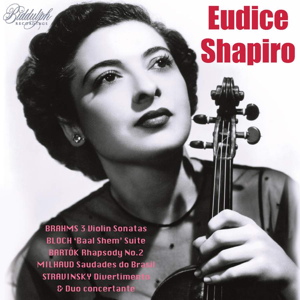
Eudice Shapiro (violin)
Ralph Berkowitz (piano), Brooks Smith (piano: Stravinsky), Paul Weston and his orchestra (Kreisler, Provost)
rec. 1957, except Stravinsky 1962, Kreisler and Provost 1958
Biddulph 85026-2 [79 + 77]
This is the second Biddulph disc devoted to violinist Eudice Shapiro to appear and follows very smartly on the heels of the earlier one devoted to her sole surviving concerto recording, examples of her as first violinist in the American Art Quartet and some of her light music recordings (review). That disc was something of a miscellany but this new release, a well-filled twofer, offers far more musical ballast and is a far better representation of Shapiro’s strengths.
For one thing it focuses on sonatas and duos and allows one to hear finely prepared, scrupulously performed examples from her repertoire taped between 1957 and 1962. The first disc focuses on the Brahms Sonatas with Ralph Berkowitz, which she plays with a burnished tone and sufficient expressive devices to generate a real sense of personalization to her performances. Her tempi are perfect throughout – or are made to seem so, so finely phrased are they – and she is able to be flexible. Vanguard’s recording is somewhat boxy but armed with some ‘Heifetz’ slides in the Sonata in G she emerges victorious over some sonic limitations. She is unsentimental in the Sonata No.2, tempi slightly slower than those of Heifetz, with whom she was for some time musically associated on the West Coast. Her playing marries dignity with expressive intensity with unerring intelligence. The D minor is similarly effective; rhythms are naturally sprung, the phrasing at the apex of the slow movement is neither overwrought nor coolly dispatched; just right. This is an admirable set, preferable – though not sonically – to the later Ferras and Barbizet, more resilient and consistent than the slightly earlier Goldberg-Balsam. The first disc ends with Bloch’s ‘Baal Shem’ suite, refined in expression and admirably nuanced.
She and Berkowitz play Bartók’s Rhapsody No.2 with tangy, resinous panache. They are as stylistically apt here as they are in the more popular Romanian Folk Dances in Zoltán Székely’s arrangement. Buciumeana is especially refined. She also plays the violin arrangements of six of Milhaud’s twelve Saudades do Brasil, an unusual assignment for the time – and an unusually large number of them too. Szigeti had recorded three and Heifetz two, but most violinists then dipped their toes into the warm Milhaud waters and taped just one or two. It was perceptive of Shapiro and the Vanguard A & R team to go much further in their exploration of Milhaud’s intoxicating polyrhythmic sensuality. She and Berkowitz perform them with succulence, colour and a sure awareness of those eruptive central contrasting sections. Ravel’s Kaddisch, by contrast, is admirably direct.
One of the reasons her Stravinsky recordings with Heifetz’s sometime accompanist, Brooks Smith, have not made much impact is that they were recorded for the rather obscure Äva label in 1962. There is a photograph, taken in the same year, and which is reproduced in the booklet, that shows composer and violin soloist laughing together, and Stravinsky’s admiration for Shapiro is well-attested. She and Smith play the Duo concertant and the Dushkin-arranged Divertimento after The Fairy Kiss. This is clean, precise, rhythmically acute Stravinsky playing and Shapiro proves an exceptionally agile and stylish exponent; her playing in the Eclogue II is especially admirable. In the Divertimento, which must have been one of the earliest LP recordings of it – though it was also recorded by Boris Goldstein, Roman Totenberg and some others (Ida Haendel had recorded it on 78s for Decca) – Shapiro is dashing and dapper and vividly conveys the music’s terpsichorean elements.
The release ends with a pendant of Shapiro the concertmistress, as we used to have it, in two luscious arrangements by Paul Weston. These are Kreisler’s Stars in My Eyes from Sissy and the evergreen Provost Intermezzo from Escape to Happiness, to both of which she brings rich tone and vibrato, though not, perhaps, in the Toscha Seidel league of Old School filmic commitment.
This is a much more recommendable Shapiro release than its confrere. The LPs have been well transferred, the notes are good and there are colour reproduction photographs of Shapiro’s c.1750 Guarneri violin which she had swapped with Daniel Karpilowsky, who took her 1688 Strad in exchange. Those were the days.
Jonathan Woolf
Help us financially by purchasing from


Contents
Johannes Brahms (1833-1897)
Violin Sonata No. 1 in G major Op.78 (1878)
Violin Sonata No. 2 in A major Op.100 (1886)
Violin Sonata No. 3 in D minor Op.108 (1886-1888)
Ernest Bloch (1880-1959)
Baal Shem Suite ‘Three Pictures of Chassidic Life’ (1923)
Béla Bartók (1881-1945)
Rhapsody for violin and piano No 2, Sz.89 (1929, rev 1935)
Romanian Folk Dances, Sz.56c (1915) arr. Zoltán Székely
Darius Milhaud (1892-1974)
Saudades do Brasil, Op. 67 (1920-21)
Maurice Ravel (1875-1937)
Deux melodies hébraïques, No.1 Kaddisch (1914)
Igor Stravinsky (1882-1971)
Duo concertant (1932)
Divertimento after The Fairy Kiss (1934) arr. Samuel Dushkin
Fritz Kreisler (1875-1962)
Stars in My Eyes from Sissy (1932) arr. Paul Weston
Heinz Provost (1890-1959)
Intermezzo, from Escape to Happiness (1938) arr. Paul Weston


















